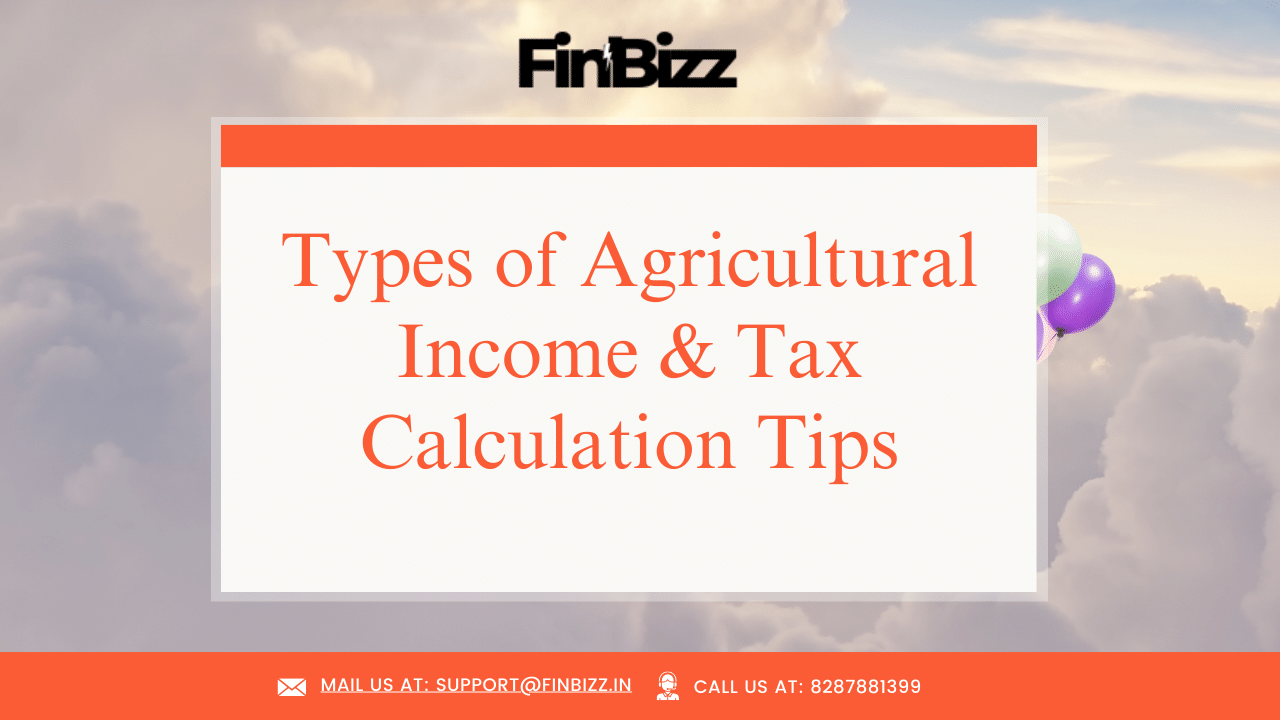Overview
Agricultural income in India is considered a vital part of the economy, influencing the livelihoods of a significant portion of the population. Recognizing its importance, the Income Tax Act of 1961 exempts agricultural income from taxation. However, the integration of agricultural income for rate purposes in tax calculations can be complex. This guide by FinBizz provides a detailed overview of the types of agricultural income and how it is factored into tax calculations under Indian law.

Understanding Agricultural Income
Agricultural income is defined under Section 2(1A) of the Income Tax Act, 1961. It includes:
- Rent or Revenue Derived from Land: This refers to the income earned from land located in India, which is used for agricultural purposes.
- Income from Agricultural Operations: This includes any income derived directly from cultivation, harvesting, and other farming activities.
- Income from Farm Building: Necessary farm buildings that are on or in the immediate vicinity of agricultural land, where such land is either assessed to land revenue in India or is subject to a local rate assessed and collected by officers of the government,.
Types of Agricultural Income
- Income from Sale of Harvested Produce: Revenue generated from the sale of crops directly harvested from the farmer’s own land.
- Rental Income from Agricultural Land: Earnings received as rent from leasing out agricultural land for farming purposes.
- Income from Agricultural Operations Involving Processing of Produce: Income derived from processing agricultural produce to increase its market value, provided the process is carried out by the cultivator or receiver of rent in kind.
- Income from Farm Buildings: Revenue from buildings used as dwellings, stores, or other outbuildings necessary for agricultural operations.

Tax Calculation for Agricultural Income
Basic Exemption and Calculation
Agricultural income is exempt from income tax. However, for individuals who have both agricultural and non-agricultural income, the tax calculation can be intricate.
Steps for Calculating Taxes:
- Compute Total Agricultural Income: Calculate the total income from various agricultural activities.
- Compute Total Non-Agricultural Income: Sum up income from non-agricultural sources.
- Aggregate the Total Income: If non-agricultural income exceeds the basic exemption limit (non-taxable limit), then agricultural income is aggregated for rate purposes.
Example of Tax Calculation:
- Agricultural Income: ₹300,000
- Non-Agricultural Income: ₹600,000
- Basic Exemption Limit for Individual Taxpayers: ₹250,000
Step-by-Step Calculation:
- Aggregate Income: ₹300,000 (Agricultural) + ₹600,000 (Non-Agricultural) = ₹900,000
- Calculate Tax on Total Income: Calculate the tax payable on ₹900,000 as per the applicable income tax slabs.
- Calculate Tax on Non-Agricultural Income plus Basic Exemption: Calculate the tax on ₹600,000 + ₹250,000 = ₹850,000.
- Tax Payable: The tax on the total aggregate income minus the tax on non-agricultural income plus basic exemption gives the actual tax liability.
This method ensures that tax is effectively levied only on non-agricultural income while still considering the tax slab benefits extended due to the agricultural income component.

Conclusion
While agricultural income is exempt from taxation, its presence affects the tax calculation for those with additional sources of income. Proper understanding and calculation are crucial to comply with tax regulations and avoiding any legal complications.
For individuals with substantial agricultural and non-agricultural incomes, it is advisable to consult with a tax professional like FinBizz to ensure accurate tax reporting and compliance.
FAQs
1. What constitutes agricultural land under the Income Tax Act?
Ans. Agricultural land is not defined in the Income Tax Act, but generally, it refers to land not situated within specified area limits; typically, land situated in any area within the jurisdiction of a municipality or cantonment board that has a population of at least 10,000 is considered non-agricultural.
2. Is income from poultry farming considered agricultural income?
Ans. No, income from poultry farming is not considered agricultural income as it does not involve cthe cultivationof land.
3. Can agricultural income be completely tax-free?
Ans. Yes, if the total income, including agriculturalincome,e does not exceed the basic exemption limit, it remains tax-free. However, the method of tax calculation changes when other sources of income are also present.




